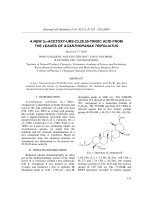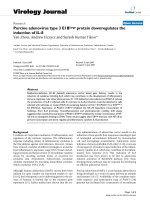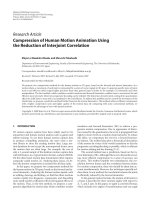Using the process of elimination 3 doc
Bạn đang xem bản rút gọn của tài liệu. Xem và tải ngay bản đầy đủ của tài liệu tại đây (64.96 KB, 6 trang )
20. Which of the following changes is needed in the
passage?
a. Part 8: Change its to it’s.
b. Part 6: Change their to its.
c. Part 6: Change than to then.
d. Part 5: Change researchers to researchers’.
21. Which of the following parts uses an adverb
incorrectly?
a. Part 2
b. Part 8
c. Part 6
d. Part 4
22. Which of the following numbered parts should
be revised to reduce unnecessary repetition?
a. Part 5
b. Part 6
c. Part 2
d. Part 8
Questions 23–25 are based on the following passage.
(1) Loud noises on buses not only irritate passengers
but also create unsafe situations. (2) They are pro-
hibited by law and by agency policy. (3) Therefore,
bus operators are expected to follow the procedures
outlined below.
(4) A passenger-created disturbance is by play-
ing excessively loud music or creating loud noises in
some other manner. (5) In the event a passenger
creates a disturbance, the bus operator will politely
ask the passenger to turn off the music or stop mak-
ing the loud noise. (6) If the passenger refuses to
comply, the bus operator will tell the passenger that
he or she is in violation of the law and bus policy and
will have to leave the bus if he or she will not com-
ply to the request. (7) If police assistance is
requested, the bus operator will stay at the location
from which the call to the Command Center was
placed or the silent alarm used. (8) The bus opera-
tor will wait there until the police arrive, will allow
passengers off the bus at this point, and no passen-
gers are allowed on until the situation is resolved.
23. Which of the following numbered parts contains
a sentence fragment?
a. Part 4
b. Part 7
c. Part 3
d. Part 6
24. Which of the following is the best revision of the
sentence numbered Part 8 in the passage?
a. Bus operators will wait there until the police
arrive, will allow passengers off the bus at this
point, and no passengers will be allowed on
until the situation is resolved.
b. Bus operators will wait there until the police
arrive, will allow passengers off the bus at this
point, and, until the situation is resolved, no
passengers are allowed on.
c. Bus operators will wait there until the police
arrive, will allow passengers off the bus at this
point, and will not allow passengers on until
the situation is resolved.
d. Bus operators will wait there until the police
arrive, will allow passengers off the bus at this
point, and no passengers will be allowed on
until the situation is resolved.
25. Which of the following numbered parts uses a
preposition incorrectly?
a. Part 2
b. Part 6
c. Part 3
d. Part 8
– THEA PRACTICE EXAM 1–
50
Questions 26–28 are based on the following passage.
(1) In 1519, Hernando cortez led his army of Span-
ish Conquistadors into Mexico. (2) E
quipped with
horses, shining armor, and the most advanced
weapons of the sixteenth century, he fought his way
from the flat coastal area into the mountainous high-
lands. (3) Cortez was lo
oking
for gold, and he were
sure that Indian groups in Mexico had mined large
amounts of the precious metal. (4) First, he c
on-
quered the groups and then seized their precious
gold using very organized methods.
26. Which of the underlined words in the passage
above could be replaced with a more precise verb?
a. was looking
b. equipped
c. conquered
d. seized
27. Which of the following sentences uses the verb
incorrectly?
a. Part 1
b. Part 2
c. Part 3
d. Part 4
28. Which of the following changes needs to be
made to the above passage?
a. Part 2: Delete the comma after horses.
b. Part 1: Capitalize the c in Cortez.
c. Part 3: Insert a comma after groups.
d. Part 4: Place a semicolon after groups.
Questions 29 and 30 are based on the following passage.
(1) A report on dropout rates in the United States
released by the U.S. Department of Education’s
National Center for Education Statistics found that
more young adults are completing high school
through alternative methods, such as the GED.
(2) “Alternative programs that give young peo-
ple a second chance are a growing phenomena,”says
U.S. Secretary of Education Richard W. Riley. (3)
“We need to develop more, higher-quality, alterna-
tive programs than meet this rising demand. (4)
Young people at risk should not just be left on their
own to hang out on the street. (5) New attention
needs to be paid to finding ways to encourage many
more dropouts to drop back in to school so that
they have a real chance at living a decent life. (6)
When young people drop out, they do more than
just give up their education, they are, too often, giv-
ing up on themselves.”
29. Which of the following changes needs to be
made to the passage?
a. Part 3: Remove the comma after more.
b. Part 1: Insert a comma after statistics.
c. Part 4: Change their to there.
d. Part 3: Change than to that.
30. Which of the following numbered parts contains
a run-on sentence?
a. Part 5
b. Part 6
c. Part 1
d. Part 2
Questions 31 and 32 are based on the following passage.
(1) Kwanzaa is a holiday celebrated by many African-
Americans from December 26 through January 1. (2)
It pays tribute to the rich cultural roots of Americans
of African ancestry, and celebrates family, commu-
nity, and culture, Kwanzaa means the first or the first
fruits of the harvest and is based on the ancient
African first-fruit harvest celebration. (3) The mod-
ern holiday of Kwanzaa was founded in 1966 by Dr.
Maulana Karenga, a professor at Callifornia State
University in Long Beach, California. (4) The seven-
day celebration encourages people to think about
their African roots as well as their life in present day
America.
– THEA PRACTICE EXAM 1–
51
31. Which of the following sentences would be the
best topic sentence for a second paragraph on the
same subject?
a. The seven fundamental principles on which
Kwanzaa is based are referred to as the Nguzo
Saba.
b. These rules consist of unity, self-determina-
tion, collective work and responsibility, coop-
erative economics, purpose, creativity, and
faith.
c. Each of its seven candles represents a distinct
principle beginning with unity, the center
candle.
d. Participants celebrate by performing rituals
such as lighting the kinara.
32. Which of the following numbered parts in the
passage contains a nonstandard sentence?
a. Part 4
b. Part 3
c. Part 1
d. Part 2
Questions 33–35 are based on the following passage.
(1) A metaphor is a poetic device that deals with
comparison. (2) It compares similar qualities of two
dissimilar objects. (3) With a simple metaphor, one
object becomes the other: Love is a rose. Although
this doesn’t sound like a particularly rich image, a
metaphor can communicate so much about a par-
ticular image, that poets utilize them more than any
other type of figurative language. (4) The reason
for this is that a poet composes poetry to express
emotional experience. (5) S
uccinctly, what the poet
imagines love to be may or may not be our percep-
tion of love. (6) Therefore, the poet’s job is to enable
us to experience it and feel it the same way. (7) You
should be able to nod in agreement and say, “Yes,
that’s it! (8) I understand precisely where this guy is
coming from.”
33. The tone of this passage is very formal; the last
sentence is not. Which of the following would be
more consistent with the tone of the passage?
a. This guy is right on.
b. I can relate to the poet’s experience.
c. I know this feeling.
d. This poem gets right to the point.
34. Which of the following numbered parts contains
a nonstandard use of a pronoun?
a. Part 3
b. Part 5
c. Part 6
d. Part 7
35. Which of the following adverbs should replace
the underlined word in Part 5?
a. Consequently
b. Normally
c. Occasionally
d. Originally
Questions 36–38 are based on the following passage.
(1) If you have little time to care for your garden, be
sure to select hardy plants, such as phlox, comfrey,
and peonies. (2) These will, with only a little care,
keep the garden brilliant with color all through the
growing season. (3) Sturdy sunflowers and hardy
species of roses are also good selections. (4) As a
thrifty gardener, you should leave part of the garden
free for the planting of herbs such as lavender, sage,
thyme, and parsley.
(5) If you have a moderate amount of time,
growing vegetables and a garden culture of pears,
apples, quinces, and other small fruits can be an
interesting occupation, which amply rewards the
care languished on it. (6) Even a small vegetable and
fruit garden may yield radishes, celery, beans, and
strawberries that will be delicious on the family
table. (7) ________________________________.
– THEA PRACTICE EXAM 1–
52
(8) When planting seeds for the vegetable garden,
you should be sure that they receive the proper
amount of moisture, that they are sown at the right
season to receive the right degree of heat, and that
the seed is placed near enough to the surface to allow
the young plant to reach the light easily.
36. Which of the following changes would best help
to clarify the ideas in the first paragraph?
a. Omit the phrase, with only a little care,from
Part 2.
b. Reverse the order of Parts 2 and 3.
c. Add a sentence after Part 4 explaining why
saving room for herbs is a sign of thrift in a
gardener.
d. Add a sentence about the ease of growing
roses after Part 3.
37. Which of the following sentences, if inserted in
the blank line numbered Part 7, would be most
consistent with the writer’s development of ideas
in the second paragraph?
a. When and how you plant is important to pro-
ducing a good yield from your garden.
b. Very few gardening tasks are more fascinating
than growing fruit trees.
c. Of course, if you have saved room for an herb
garden, you will be able to make the yield of
your garden even more tasty by cooking with
your own herbs.
d. Growing a productive fruit garden may take
some specialized and time-consuming
research into proper grafting techniques.
38. Which of the following changes needs to be
made in the passage?
a. Part 8: Change sown to sewn.
b. Part 5: Change languished to lavished.
c. Part 2: Change through to threw.
d. Part 8: Change surface to surfeit.
Questions 39 and 40 are based on the following passage.
This selection is from Willa Cather’s short story,
“Neighbor Rosicky.”
(1) On the day before Christmas the weather set in
very cold; no snow, but a bitter, biting wind that
whistled and sang over the flat land and lashed one’s
face like fine wires. (2) There was baking going on in
the Rosicky kitchen all day, and Rosicky sat inside,
making over a coat that Albert had outgrown into an
overcoat for John. (3) Mary’s big red geranium in
bloom for Christmas, and a row of Jerusalem cherry
trees, full of berries. (4) It was the first year she had
ever grown these; Doctor Ed brung her the seeds
from Omaha when he went to some medical con-
vention. (5) They reminded Rosicky of plants he
had seen in England; and all afternoon, as he
stitched, he sat thinking about the two years in Lon-
don, which his mind usually shrank from even after
all this while.
39. Which of the following numbered parts uses a
verb form incorrectly?
a. Part 5
b. Part 2
c. Part 4
d. Part 3
40. Which of the following numbered parts contains
a sentence fragment?
a. Part 4
b. Part 3
c. Part 2
d. Part 5
– THEA PRACTICE EXAM 1–
53
Section 3: Writing (Part B—
Writing Sample)
Carefully read the writing topic that follows, then pre-
pare a multiple-paragraph writing sample of 300–600
words on that topic. Make sure your essay is well-
organized and that you support your central argument
with concrete examples.
Bob Maynard has said that “Problems are opportu-
nities in disguise.”
Write an essay describing a time in your life
when a problem became an opportunity. How did
you transform the situation? Explain what you did
to turn the problem into an opportunity and how
others can benefit from your experience.
– THEA PRACTICE EXAM 1–
54
Answer Explanations
Section 1: Reading
1. a. Choice b emphasizes only damage to the atmos-
phere; the passage encompasses more than that.
Choice c does not mention the atmosphere,
which is the main focus of the passage. Choice
d is too narrow—the final paragraph of the pas-
sage emphasizes that the circulation of the
atmosphere is but one example of the complex
events that keeps the Earth alive.
2. c. Choice a is incorrect because the passage does
not explain exactly what will happen as a result
of damage to the atmosphere and other life-
sustaining mechanisms. Choice b is incorrect
because the passage does not explain the origin
of the atmosphere. Choice d is incorrect because
it is solar energy that travels 93 million miles
through space, not the atmosphere.
3. b. The biosphere, as defined in the first paragraph,
is a region (or part) of the Earth; it is not the
envelope around the Earth, the living things on
Earth, or the circulation of the atmosphere
(choices a, c, and d).
4. d. Choice a deals with solar radiation, not with
circulation of the atmosphere. Choice b is an
assertion without specific supporting detail.
Choice c describes how the atmosphere pro-
tects Earth but does not speak of the circulation
of the atmosphere. Only choice d explains that
conditions would be unlivable at the equator
and poles without the circulation of the atmos-
phere; therefore, it is the best choice.
5. a. The second paragraph deals with how varia-
tions in the strength with which solar radiation
strikes the Earth affects temperature. None of
the other choices is discussed in terms of all
temperature changes on Earth.
6. a. There is no mention in the first paragraph of any
reviving or cleansing effect the atmosphere may
have (choices b and d). In a sense, enabling the
Earth to sustain life is invigorating; however,
choice a is a better choice because the first two
sentences talk about how the atmosphere pro-
tects the Earth from harmful forces.
7. b. Choice b includes the main points of the passage
and is not too broad. Choice a features minor
points from the passage. Choice c also features
minor points, with the addition of History of
the National Park system, which is not included
in the passage. Choice d lists points that are not
discussed in the passage.
8. d. The information in choices a, b, and c is not
expressed in paragraph 4.
9. a. Reread the second sentence of paragraph 2.
Choices b
and c are mentioned in the passage
but not as causing the islands; choice d is not
mentioned in the passage.
10. c. Paragraph 5 discusses the visitors to Acadia
National Park, whereas choices a, b, and d are
not mentioned in the passage.
11. a. The first sentence of paragraph 3 states that the
length of the Maine coastline is 2,500 miles.
12. b. The other choices could possibly be true, but
only choice b fits in the context of the sentence
that follows it, which describes the ruggedness
of the coast and implies that the coast does not
lie in a straight line.
13. d. The passage contains objective information
about accounting such as one might find in a
textbook. There is nothing new or newsworthy
in it (choice a). The passage does not contain the
significant amount of personal opinion one
would expect to find in an essay (choice b). It
does not deal with matters that might involve lit-
igation (choice c).
14. d. The final sentence of the second paragraph
emphasizes the importance of correct interpre-
tation of financial accounting. Choice a is incor-
rect because something so important would not
be discretionary (optional). Choice b may be
true, but it is not as important for guidelines to
– THEA PRACTICE EXAM 1–
55









